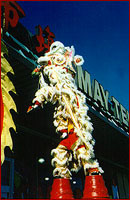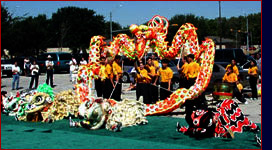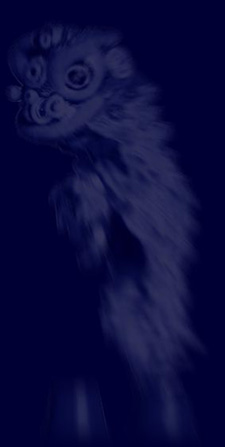|

 |
 |
Hundreds
of years ago, a small Chinese village was
threatened on the eve of the lunar new year
by local bandits who dressed themselves as
strange beasts (nien). The beasts scared the
villagers away and looted their homes and
farmland. Frightened and discouraged from
being left hungry and poor, the villagers
decided to stand up to the unknown beast and
crafted costumes that resembled a lion. These
costumes were made of bamboo frames and covered
with paper mache painted in bright colors
and details. The dancers in the costumes would
dance while others hit pots and pans to make
noise. With all the commotion and costumed
people dancing under the mysterious costumes,
the villagers were able to scare away the
bandits. This eventually led them to believe
that the Lion Dance wards off bad luck, scares
away evil spirits, and ushers in good luck.
To commemorate the event, the dance was passed
from generation to generation, gradually becoming
a part of the Chinese traditional martial
arts. Whenever the people celebrate, it was
inevitable that the dance was performed as
a form of thanks-giving. From that moment,
the tradition of Lion Dance was born.
Although
lions are not native in China, they came to
this country via the famous Silk Road. Rulers
in what is today Iran and Afghanistan sent
lions to Chinese emperors as gifts in order
to get the right to trade with Silk Road merchants.
The lion dance dates back to the Han Dynasty
(205 B.C. to 220 A.D in China) and during
the Tang Dynasty (716-907 A.D.) it was at
its peak. It was particularly performed during
religious festivals. The lion dance was not
only introduced in China, but also in Korea
and Taiwan, where lions are not native as
well. The dances are not exactly the same
in these countries, but the symbolism is quite
similar.
|

Lion
and Dragon Dance embraces the beauty, art, culture,
traditions, and history of China. A good performance
is believed to bring luck and happiness. Gestures
and movements that closely mimick the emotions
of the mystical animal tells the story behind
the performance. Emotions and expressions portrayed
by the dancers include excitement, caution, curiosity,
playful, anger, sleepiness, confusion, happiness,
and sadness, to name a few. In addition to this,
acrobatic skills are sometimes displayed by the
dancers to add excitement to the performance.
The
Lion is made of paper mache and is controlled
by two people. One person plays the head, and
the other person plays the tail and they both
choreograph their movements to the rhythm of a
drum beat. The choreographed set usually takes
place in a setting of a story where a hungry lion
awakens and seeks out food most commonly in the
form of lucky green lettuce. This lucky lettuce
is offered by the people and is usually placed
in a manner that the Lion must move about an obstacle
in order to grab and eat it. Some of these obstacles
require the Lion to climb, jump, or move about
cautiously to check for traps and other ambushes
to ensure a safe path to the lucky green.
 |
 |
Sometimes
seen accompanying the Lion is the comical
monk, who plays the role of the Lion's mentor
and helps it seek out the lucky green lettuce.
The monk has a very large round head and is
always in good spirits. His lighthearted character
often acts foolish and silly, making him very
likeable.
The
lion is an important Chinese totem, the symbol
of power, majesty and courage, capable of
warding off evil spirits. In Chinese legend
it is said that the lion was the ninth son
of the dragon and was the best employable
guard, thus it was usually seen in front of
royal palaces, offices and residences. Lion
and Dragon dance is more frequently performed
during the Lunar New Year and can be seen
in all parts of the community including schools,
birthdays, corporate functions, sponsored
events, festivals, and even Bah Mitzvahs.
|

 The
Chin Woo Lion & Dragon Dance Team, based in
Richardson, a suburb of North Dallas, is led by
Kungfu and Tai Chi Master Jimmy Wong. He is the
International Judge for the International Dragon
and Lion Dance Federation headquartered in Hong
Kong, and also the US representative for the committee.
At the international level, the Team is credited
with representing the US Team in Hong Kong for
the 1995 World Lion Dance Festival. Locally, the
Team is known as being the leading authority in
Lion & Dragon Dance and has travelled all
over the southwest region to entertain and ultimately
educate the public about lion & dragon dance. The
Chin Woo Lion & Dragon Dance Team, based in
Richardson, a suburb of North Dallas, is led by
Kungfu and Tai Chi Master Jimmy Wong. He is the
International Judge for the International Dragon
and Lion Dance Federation headquartered in Hong
Kong, and also the US representative for the committee.
At the international level, the Team is credited
with representing the US Team in Hong Kong for
the 1995 World Lion Dance Festival. Locally, the
Team is known as being the leading authority in
Lion & Dragon Dance and has travelled all
over the southwest region to entertain and ultimately
educate the public about lion & dragon dance.
The
objective of our team is to educate the public
about lion and dragon dance through performances,
lectures, presentations, and interaction. We feel
that knowledge and understanding is a crucial
element to appreciating the Asian arts and traditions,
so we would like achieve this by being visible
to the community as much as possible and providing
noteworthy information about lion & dragon
dance and explain how it associates with Asian
culture and traditions.
If
you are an educator, business owner, or event
organizer, please feel free to browse this site
for information about Chinese Lion and Dragon
Dance. If you have questions about hosting the
Chin Woo Lion & Dragon Dance Team to perform,
you may contact us for
details.
|

